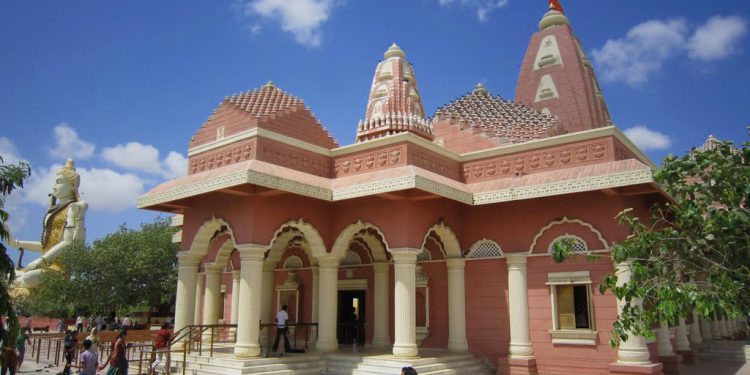NageshwarJyotirlingais one of the 12Jyotirlingashrines mentioned in theShiva Purana. Nageshvara is believed to be the first such shrine.
Shrine’s History
The Jyotirlinga situated in the temple is considered to protect everybody from all sort of poisons. It is believed that one who offers prayers in the temple becomes poison free. It is said that those who pray to the Nageshwar Linga become free of poison. The Rudra Samhita sloka refers to Nageshwar with the phrase ‘Daarukaavane Naagesham’.

Legends Associated with This Shrine
The Shiva Purana says NageshwarJyotirlinga is in ‘the Darukavana’, which is an ancient name of a forest in India. ‘Darukavana’ finds mention in Indian epics, such as Kamyakavana, Dvaitavana, Dandakavana. A narrative in the Shiva Purana about the Nageshvara Jyotirlinga tells of a demon named Daaruka, who attacked a Shiva devotee named Supriya and imprisoned him along with many others in his city of Darukavana, a city under the sea inhabited by sea snakes and demons. At the urgent exhortations of Supriya, the prisoners started to chant the holy mantra of Shiva and immediately thereafter Lord Shiva appeared and the demon was vanquished, later residing there in the form of a Jyotirlinga.
The demon had a wife, a demoness named Daaruki who worshipped Mata Parvati. As a result of her penance and devotion, Mata Parvati enabled her to master the forest where she performed her devotions and renamed the forest ‘Darukavana’ in her honour. Wherever Daaruki went the forest followed her. In order to save the demons of Darukavana from the punishment of the gods, Daaruka summoned up the power Parvati had given her.
She then moved the entire forest into the sea where they continued their campaign against the hermits, kidnapping people and keeping them confined in their new lair under the sea, which was how that great Shiva devotee, Supriya, had wound up there. The arrival of Supriya caused a revolution. He set up a lingam and made the prisoners recite the mantra Om Namaha Shivay in honour of Shiva while he prayed to the lingam.
The demons’ response to the chanting was to attempt to kill Supriya, though they were thwarted when Shiva appeared and handed him a divine weapon that saved his life. Daaruki and the demons were defeated and Parvati saved the remaining demons. The lingam that Supriya had set up was called Nagesha; it is the tenth lingam. Shiva once again assumed the form of a Jyotirlinga with the name Nageshwar, while the Goddess Parvati was known as Nageshwari. Lord Shiva then announced that he would show the correct path to those who would worship him.

Architectural Relevance of This Shrine
Nageshwar Mahadev Sivalingam is facing South while the Gomugam is facing east. There is a story for this position. A devotee by name Naamdev was singing bhajans in front of the Lord. Other devotees asked him to stand aside and not hide the Lord. To this Naamdev asked them to suggest one direction in which the Lord does not exist, so that he can stand there. The enraged devotees carried him and left him on the southside. To their astonishment, they found that the Linga was now facing South with the Gomugam facing east.
Shrine’s Map Location and How to Go There
By Road
There is regular bus service from Jamnagar, Rajkot and other nearby towns connected to Dwarka.
By Rail
The nearest railway station to nageshwarjyotirlinga temple is Dwarka Train Station which is 0 km away from Nageshwar Jyotirlinga Temple.
By Air
Jamnagar, 145 km away, is the nearest airport.
Shrine Timings
On a normal day, the doors of Nagnath Jyotirlinga open at 4 am. During the first hour, Pooja and Rudrabhishek are performed by temple priests. The temple closes at 9:00 pm on a normal day, but during Holy Shravan month, the timings are extended.
Unlike Somnath or Rameshwaram or Srisailam, here the devotees enjoy the privilege of offering Abhishek themselves on Jyotirlinga.
Mahanaivadya and Aarti 12 noon and 12:30 p.m..
Shri Shayanarti pooja between 8:30 p.m and 9:00 p.m.
06:00 am ? Devotees are allowed inside the Garbhagriha (only for special Puja and Darshan.)
04:00 pm ? Sringaar Darshan
04:30 pm ? Entry inside Garbhagriha is closed for Devotees
19:00 pm ? Sandhya Aarti
Events Celebrated at This Shrine
The main religious festivals of this shrine are Magh Month festival in January-February, Ganesh Chaturthi (Vinayaka Chaturthi) in August-September, regional New Year and English New Year days, Makar Sankranti, Special pujas are performed in the temple for Lord and Goddess Ambika on Deepavali, Pradosha days 13th day of New Moon or Full Moon days, procession of Lord in Kailash Vahan, 29 day Brammotsavam in May-June, Skanda Sashti in October-November, Maha Shivarathri in February – March and 10 day Ashada Purnima (Aadi Pooram) in July-August.













































